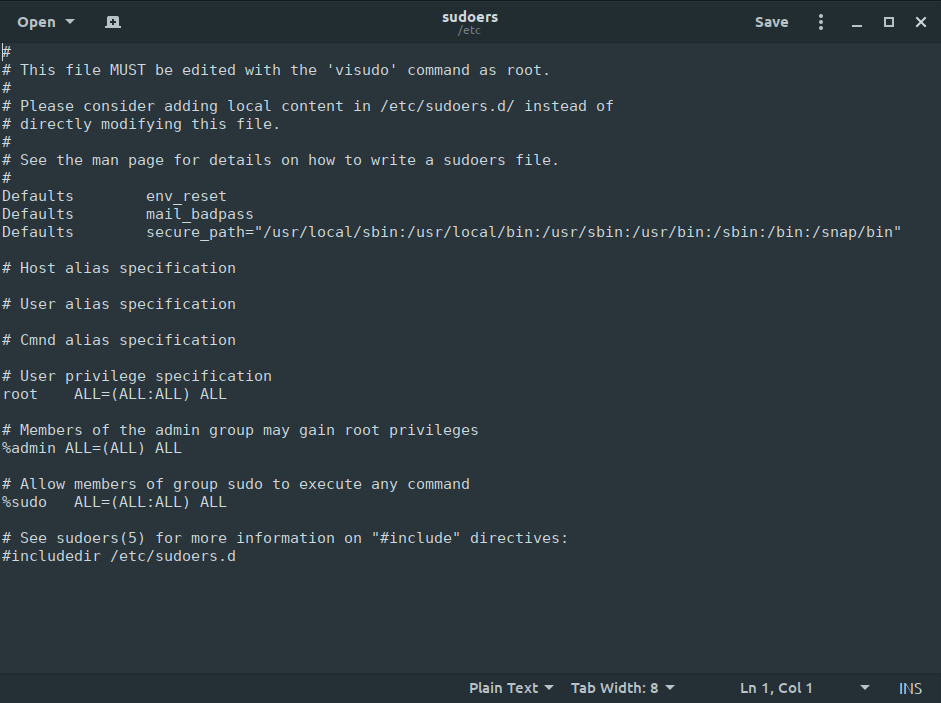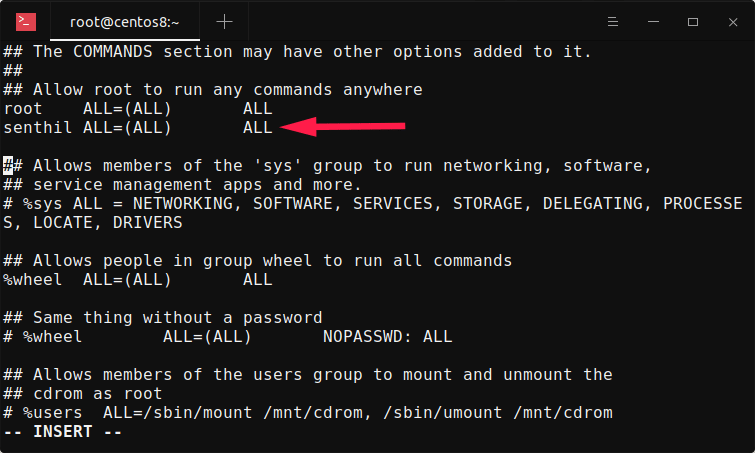

- #CENTOS PASSWORDLESS SUDO HOW TO#
- #CENTOS PASSWORDLESS SUDO INSTALL#
- #CENTOS PASSWORDLESS SUDO PASSWORD#
ismail ALL=(ALL:ALL) NOPASSWD: /bin/passwd In the following example, the user ismail can run /bin/passwd commands with sudo without a password.

WIth sudo -s you may not get the extra system path for root. With your setup, you could do something like sudo su and it wont ask for a password.

#CENTOS PASSWORDLESS SUDO PASSWORD#
All other commands with sudo will require a password too. sudo and su are two different commands, and do different things. But we can set a specific command to run with sudo without a password. By default, the NOPASSWD will disable the password for all commands with the sudo. %sys ALL=(ALL:ALL) NOPASSWD: ALL NOPASSWD For Command or ApplicationĪnother use case for the NOPASSWD configuration is disabling the sudo password for a specific command. ismail ALL=(ALL:ALL) NOPASSWD: ALL NOPASSWD For GroupĮven we have set the sudo group for passwordless sudo command let’s make a different example by setting the sys group for passwordless sudo command. In the following example, we will set the user ismail to run the sudo command without asking a password. We will just provide the username and change with the group name like below. We can also disable the sudo password for a specific user. %sudo ALL=(ALL:ALL) NOPASSWD: ALL NOPASSWD For User The sudoers configuration file can be opened with a command line or GUI editor but the most secure way to prevent errors and lockdowns is using the visudo command like below. In order to make the the sudo command passwordless we should edit this file. In installation step before, where you add host, make sure than that your have entered that username and password.
#CENTOS PASSWORDLESS SUDO INSTALL#
Instead of userid put your username with sudo privileges which you used to install Cloudera.
#CENTOS PASSWORDLESS SUDO HOW TO#
Add line: userid ALL (ALL:ALL) NOPASSWD: ALL. vaso de 10 oz How To Enable Passwordless Sudo For A Specific User in Linux linux - How to set up password-less SSH for all users - Super User iniatinklisYouve. The sudoers configuration file is used to set configuration about the sudo command. How to create a new user with password less sudo configuration in Centos 9. What worked for me on Ubuntu: Edit /etc/sudoers. The sudo command provides the ability to run without any password which is also called as nopasswd configuration. But for heavy usage provide or typing the password is not a practical method. By default, the sudo command asks for the current user password to provide root privileges as a security measure. As passwordless login is set up I do not need to enter a password to ssh BUT as I am running sudo on. The sudo command configuration is located in the /etc/sudoers file. centos sudo /sbin/shutdown -h now PASSWORD : 123ABC. The sudo command is very popular for daily usage power users generally provided the ability to run sudo command. provide the sudo command in order to execute and run a command with root privileges without logging as the root user. Im not a big fan of this because sudo shouldnt need to rely on a NOPASSWD: configuration and I dont feel that its designed to be invoked indirectly. These daemons are notorious for having problems.Linux distributions like Ubuntu, Debian, Mint, Kali, CentOS, RHEL, SUSE, etc. If you have a caching daemon running, perhaps nscd or sssd, restart the daemon ('sudo service nscd restart'). If they can't successfully use their password anywhere, start looking at changes against /etc/passwd, /etc/shadow, /etc/nf, and any config files associated with the directory you're using (perhaps none, perhaps LDAP, NIS, AD). So to me the best option when using the SLES images is to set the root password after deploying the VM or if you prefer to use the user password instead of the target user password when using sudo to comment that option like you did. Is smithj logging in via password? Or via keys? Make sure they can log in with a password to help narrow the problem. Lets assume you want all sudo users (i.e. One potentially tricky problem is if the account is allowed access from a remote IP, but not locally this ends up allowing a remote log in, but local actions like cron jobs and sudo authentications fail. The answer mentioning to set a host confused me, as I want to be able to have a sudo user be able to run privileged commands without requiring to consider such 'host aspect' any host should work, hence I use the special ALL reserved word. If so, you'll want to check whether smithj is allowed in /etc/security/nf (unless another file is specified by the pam module).

Look at /etc/pam.d/system-auth and see if the pam_access.so module is in use. Subtle changes to this system can introduce gnarly troubleshooting problems. If you can't manage this, there's a fundamental issue authenticating that's probably separate from sudo itself.Ĭompare /etc/pam.d/sudo with other functional systems (or backups).Ĭompare /etc/pam.d/system-auth with other functional systems (or backups). This just asks sudo to tell you what permissions you have.


 0 kommentar(er)
0 kommentar(er)
